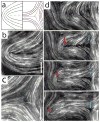Spontaneous motion in hierarchically assembled active matter
- PMID: 23135402
- PMCID: PMC3499644
- DOI: 10.1038/nature11591
Spontaneous motion in hierarchically assembled active matter
Abstract
With remarkable precision and reproducibility, cells orchestrate the cooperative action of thousands of nanometre-sized molecular motors to carry out mechanical tasks at much larger length scales, such as cell motility, division and replication. Besides their biological importance, such inherently non-equilibrium processes suggest approaches for developing biomimetic active materials from microscopic components that consume energy to generate continuous motion. Being actively driven, these materials are not constrained by the laws of equilibrium statistical mechanics and can thus exhibit sought-after properties such as autonomous motility, internally generated flows and self-organized beating. Here, starting from extensile microtubule bundles, we hierarchically assemble far-from-equilibrium analogues of conventional polymer gels, liquid crystals and emulsions. At high enough concentration, the microtubules form a percolating active network characterized by internally driven chaotic flows, hydrodynamic instabilities, enhanced transport and fluid mixing. When confined to emulsion droplets, three-dimensional networks spontaneously adsorb onto the droplet surfaces to produce highly active two-dimensional nematic liquid crystals whose streaming flows are controlled by internally generated fractures and self-healing, as well as unbinding and annihilation of oppositely charged disclination defects. The resulting active emulsions exhibit unexpected properties, such as autonomous motility, which are not observed in their passive analogues. Taken together, these observations exemplify how assemblages of animate microscopic objects exhibit collective biomimetic properties that are very different from those found in materials assembled from inanimate building blocks, challenging us to develop a theoretical framework that would allow for a systematic engineering of their far-from-equilibrium material properties.
Figures




Comment in
-
Active matter: Spontaneous flows and self-propelled drops.Nature. 2012 Nov 15;491(7424):340-1. doi: 10.1038/nature11750. Epub 2012 Nov 7. Nature. 2012. PMID: 23135394 No abstract available.
References
-
- Bray D. Cell Movements: From Molecular to Motility. Garland Publishing; 2000.
-
- Marchetti MC, et al. Soft Active Matter. 2012 arXiv:1207.2929.
Publication types
Grants and funding
LinkOut - more resources
Full Text Sources
Other Literature Sources

